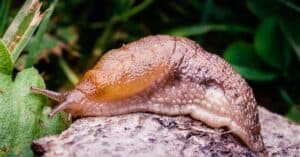Whether you keep slugs as pets or you’ve seen slugs around your house, we’re sure you’ve landed on our website because you’re eager to know what their poop looks like! What do these tiny creatures eat? How do they digest their food? How do they poop? Where does their poop come out from? And finally, do slugs eat other animals’ poop? This is a guide to everything you need to know about the topic!
What are slugs?
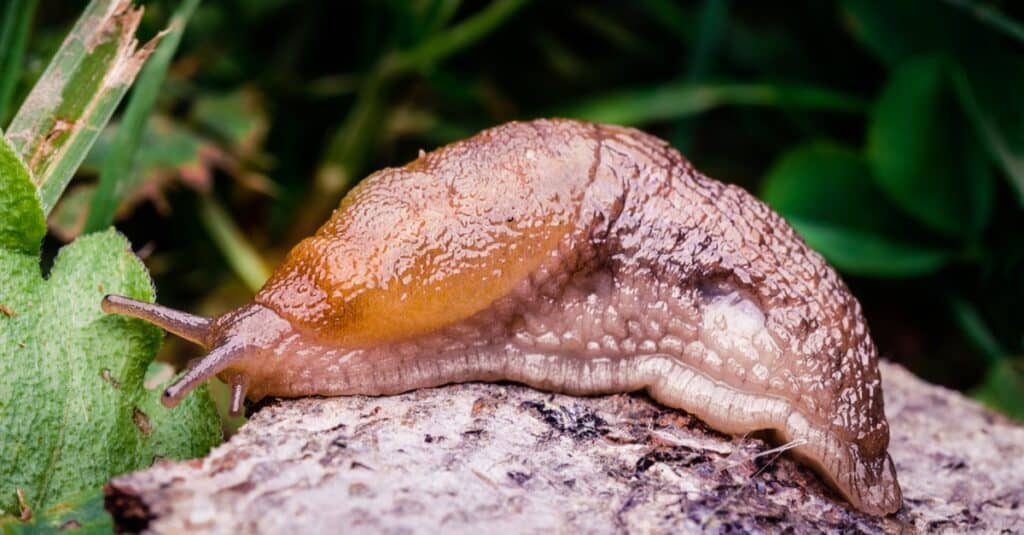
Slugs are gastropod mollusks with little or no shells that live on land.
©scott conner/Shutterstock.com
Slugs are gastropod mollusks with little or no shells that live on land. This term is polyphyletic, which describes a group of organisms that share some characteristics but do not necessarily have a common ancestor. There are numerous slug species, but some of the most common ones are the banana slug (Ariolimax), the leopard slug (Limax maximus), the garden slug (Arion hortensis), and the Kerry slug (Geomalacus maculosus). These organisms can be found worldwide under rocks, logs, or ground debris.
We bet you’ve wondered whether slugs and snails are the same animals at least once! Well, they are not. While slugs have straight bodies, snails’ bodies are coiled and have spiral-shaped shells.
Slugs are usually gray, brown, green, yellow, black, and sometimes red or orange. Some slug species have patterned skin. Their average length is 4-8 inches. A slug’s body is thick in the middle and tapered at each end. Slugs have two pairs of tentacles; the upper tentacles have eyespots on the end, which are used for seeing and smelling, while the lower tentacles are used for feeling and tasting. One unique slug characteristic is that it can regrow its eyespots if damaged.
Slugs can be omnivorous, herbivorous, carnivorous, and even detritivorous. Here’s what slugs eat:
A slug’s lifespan may vary from six months to two years. However, some slugs have lived as long as six years.
Do slugs leave poop?
Like other animals, slugs poop too. After eating and digesting the food, they excrete poop. Its color depends on what the slugs eat.
How do slugs poo?
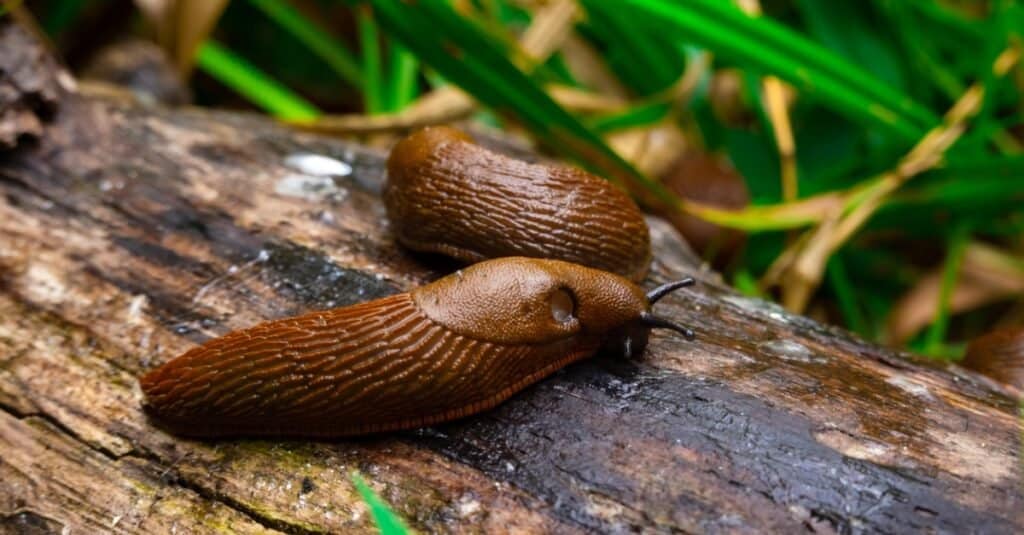
Slugs poop through their anus, located under the mantle, on the right side of their body, near the genital opening.
©iStock.com/Ja’Crispy
A slug poops through its anus, located under the mantle, on the right side of its body, near the genital opening. The genital opening is located on the slug’s mantle. So, unlike other animals, slugs have their anuses close to their heads. Why, you might be wondering, right?! That’s because they’re relatives of snails, and snails have their anuses outside their shells.
Slugs’ digestive system
According to A. South, a slug’s digestive system consists of the following:
- Buccal mass;
- Esophagus;
- Two salivary glands with two ducts;
- Crop wall;
- Intestine;
- Stomach;
- Duct to the anterior lobe of the digestive gland;
- Duct to the posterior lobe of the digestive gland;
- Rectum;
- Anus.
Here’s how their digestive system works. Slugs feed, then their radula shreds the food into tiny pieces that, in turn, reach the buccal cavity and the esophagus. The food pieces mix with mucus and saliva and go to the crop.
The crop walls produce peristaltic movements that help digest the fat, proteins, and polysaccharides. The crop wall also helps absorb fatty acids. The food then goes into the stomach. The digested pieces end up in the intestine as packed food pieces covered in mucus. More mucus gets mixed with the digested food in the intestine, and then they leave the body through the slug’s anus.
What does slug poop look like?

Slug poop usually consists of packed pieces of excrement covered in mucus.
©iStock.com/maerzkind
Slug poop usually consists of packed pieces of excrement covered in mucus.
Is slug poop dangerous?
Slugs and snails may carry the rat lungworm parasite, whose primary host is the rat. Slugs get it by eating rat poop. The rat lungworm may be spread to humans but can’t complete its cycle in the human body. However, it may still be dangerous, and infected patients may require great care and treatment.
Slugs can also be hosts to the Angiostrongylus costaricensis parasite, which is related to the rat lungworm. This parasite can survive in the human body in the gastrointestinal tract.
Humans can get these parasites if they handle slugs without gloves and without thoroughly washing their hands afterward. Moreover, people may get this parasite if they accidentally eat a slug or eat undercooked slugs or snails.
Do slugs like poop?
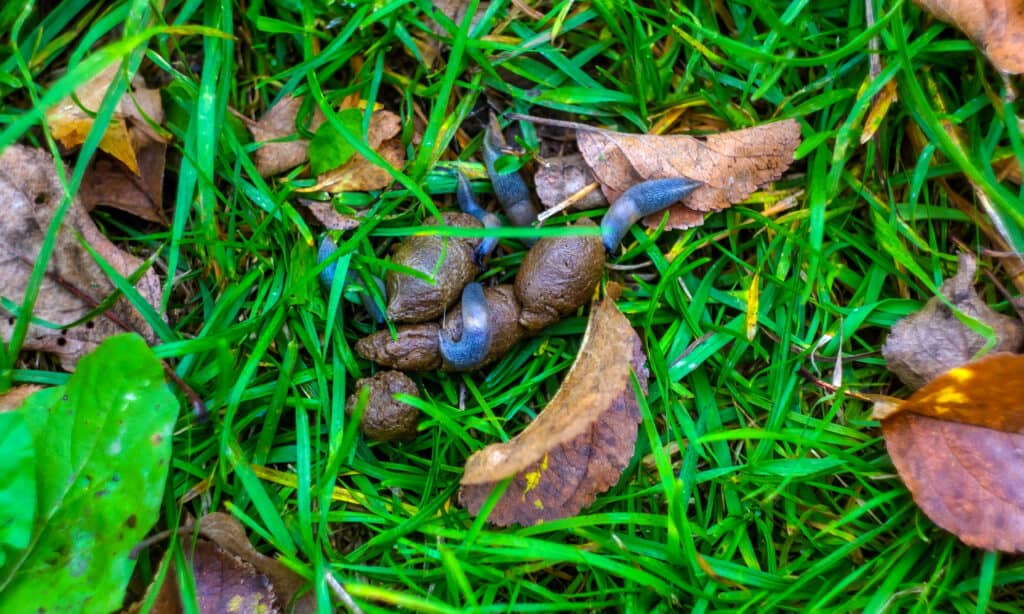
Besides delighting in plants, worms, or snails, slugs love poop, too.
©moskvich1977/Shutterstock.com
If you have a dog, you might have noticed that slugs and snails gather around your dog’s poop. So why do they do that? Do slugs like poop?! Yes, they do! Besides delighting in plants, worms, or snails, slugs love poop, too! It’s organic, isn’t it?!
Can you keep slugs as pets?

Slugs are often kept as pets.
©weha/Shutterstock.com
Slugs are often kept as pets. If you’re planning to keep a slug as a pet, here’s what you should consider:
- You’ll need to prepare a proper habitat for your slug. It can be kept in a storage box or even in an aquarium with a lid.
- Your slug’s house may be “decorated” with rocks, leaves, grass, soil, and dirt.
- Don’t forget to clean your slug’s home. Check its humidity daily and clean it carefully every two weeks.
Don’t forget that slugs can carry parasites. It’s highly recommended to wear gloves while handling them and wash your hands thoroughly afterward.
Incredible facts about slugs
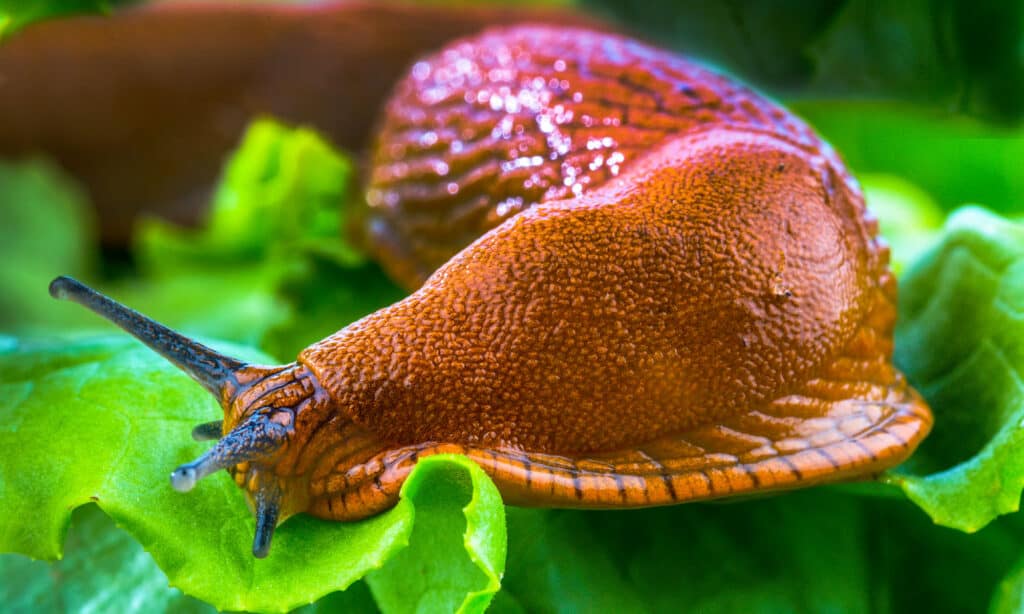
Slugs smell through their eyes.
©Lisa-S/Shutterstock.com
- Slugs smell through their eyes.
- Sea slugs are probably the largest species, growing as long as 40 inches (101 centimeters) and weighing as much as 30 pounds (13.6 kilograms)! Imagine a slug weighing as much as a medium-sized dog!
- Slugs can fertilize their eggs! They can lay up to 500 eggs every year!
- Slugs don’t have bones.
- A. South, in “Terrestrial Slugs: Biology, ecology, and control,” states that slugs have become more and more important because they are “agricultural and horticultural pests” and they are “useful experimental animals, particularly in the field of neurophysiology.”
- A slug’s top speed is 0.18 miles per hour (0.29 kilometers per hour).
The photo featured at the top of this post is © Lisa-S/Shutterstock.com
Thank you for reading! Have some feedback for us? Contact the AZ Animals editorial team.



